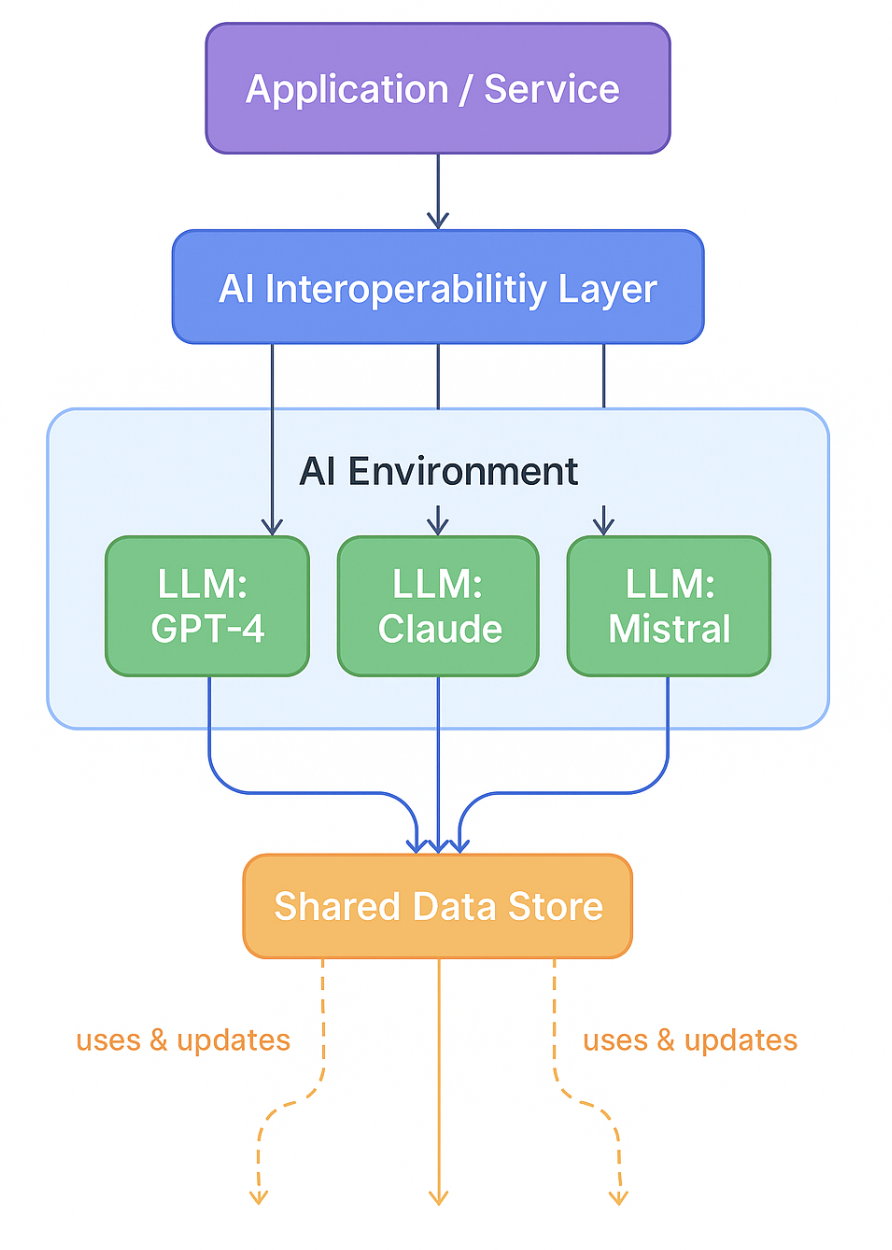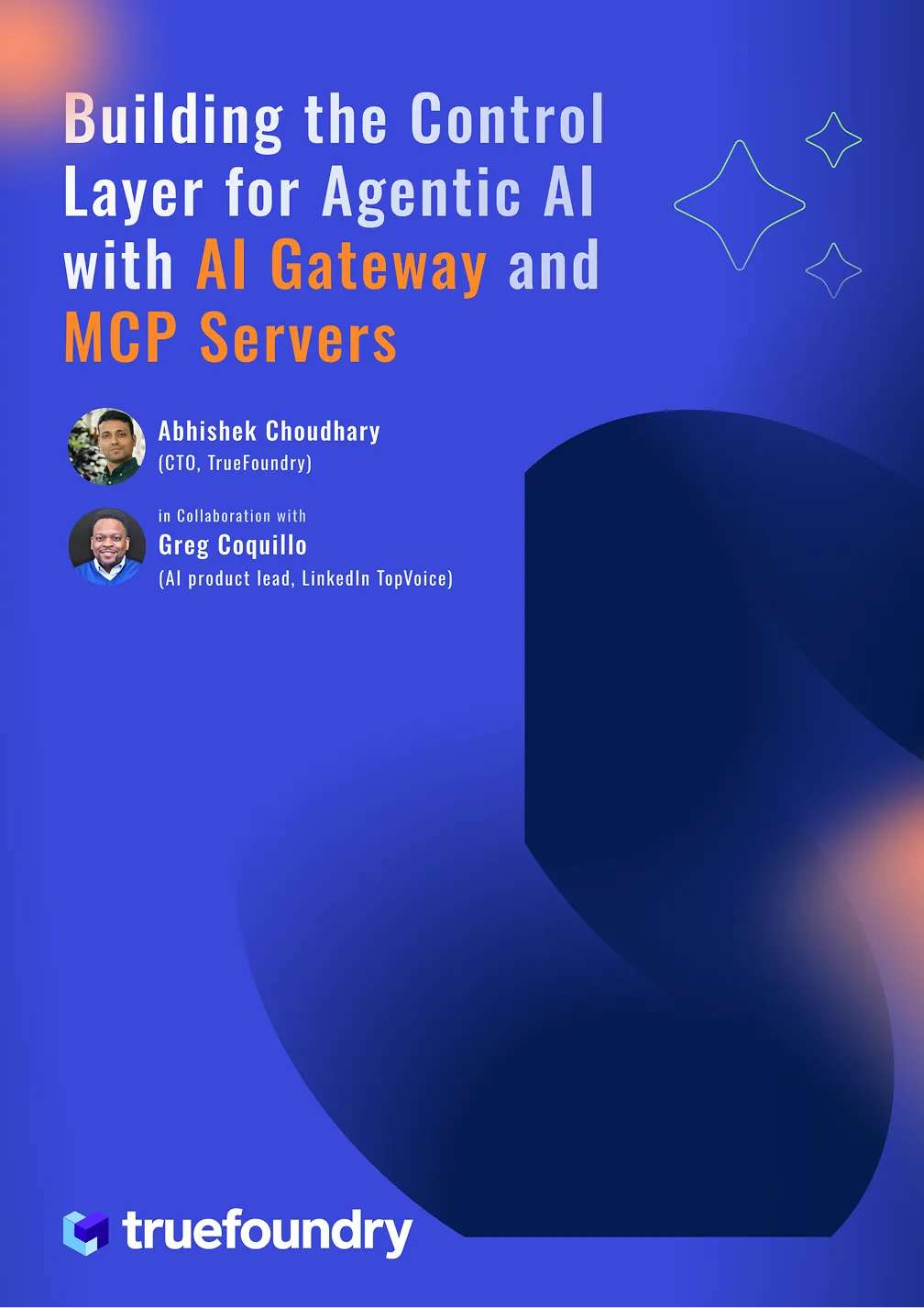AI Interoperability: How AI Gateways Solve the Multi-Model Challenge
AI infra isn’t a single monolith now, it has evolved into an ecosystem of models, agents, tools, data stores and control planes. AI infrastructure has evolved beyond a single model or platform. Today’s enterprise stack is a sprawling ecosystem of LLMs, agents, vector databases, orchestration frameworks, and control planes — each with its own APIs, formats, and governance rules. At enterprise level this heterogeneity creates both opportunities and problems, teams can pick the best model for a job, but different providers speak different APIs, return different shapes, and need different governance.
Enterprises want the flexibility to use the best model for each task, but every provider speaks a different API, returns a different schema, and requires different credentials. Without a unifying layer, teams end up writing brittle integrations and managing scattered observability and compliance.
The answer is architectural, not procedural.
AI interoperability must be designed — not patched. And the key enabler of that design is the AI Gateway: a central layer that standardizes how applications interact with models, tools, and agents. An AI Gateway acts as the “common language” of your AI ecosystem. It normalizes inputs and outputs, enforces security and compliance policies, routes traffic intelligently, and provides unified observability. In short, it turns fragmented AI infrastructure into a cohesive, governed system.
What Is AI Interoperability?
In very simple terms AI Interoperability is the ability of AI systems to work and integrate together in a seamless manner. This in turn means your stack follows common interfaces and formats, for example handing over a task from model A to model B should not require schema level changes, or change in API configurations. AI interoperability lets “different models, APIs, data formats, and systems work together without requiring custom code for every integration. In other words, you can switch between providers, combine multiple LLMs, or upgrade models—all without breaking your existing infrastructure.

Another aspect to AI Interoperability is making “different AI systems, models, and agents work together, seamlessly exchanging data, making decisions collaboratively, and triggering actions across platforms”. This goes beyond just APIs: it means AI agents share context and language, coordinate their tasks, and reuse each other’s outputs. Think of it like connected workflows in an organization – your email, CRM, and project tracker each have their own job, but when they share data they form a smooth automated process. AI interoperability similarly reduces silos by letting models and tools talk a common language.
AI Interoperability is all about building flexible and modular systems with :
- Standardized APIs/SDKs : unified interface that hides each model’s unique endpoint and credential details.
- Data and schema consistency : Using common formats (e.g. JSON schemas or vector embeddings) so all parts of the system understand inputs/outputs.
- Unified tooling : Shared prompt templates, normalization of outputs, and common monitoring/logging pipelines.
- Dynamic orchestration : A control plane that can route tasks among models based on performance, cost or other criteria.
Why Does AI Interoperability Matters ?
Flexible and modular systems are good to have but hard to maintain, why do we even need AI Interoperability?
The answer is short and simple, and let’s understand it with a simple example. Suppose you want to use 2 different models Gemini, and Claude for a single task, Gemini specializes in handling very long context windows, whereas Claude specializes in depth reasoning problems, having a single unified interface which lets you switch models easily, eliminates your code level changes, and makes your application more robust due to diversity of tasks it can handle. Another good example is how some small models might help in handling easier queries, and save a ton of cost, as complex reasoning LLMs can shoot up your cost pretty quickly.
Interoperability reduces:
- Vendor lock-in: You can switch or add models without large rewrites.
- Integration overhead: Teams spend less time on API plumbing and more on building value.
- Cost: Route high-throughput workloads to cheaper models, reserve premium ones for critical tasks.
- Operational risk: Failover models can be configured for reliability and compliance continuity.
In a world where new models appear weekly, interoperability ensures your stack remains adaptive, resilient, and future-proof, improves productivity, decision quality, amplifies AI strengths, makes AI orchestration faster and brings down integration costs.
Core Components of Interoperable AI Systems
Enterprise-grade interoperability can be understood across three layers:
Additional building blocks include:
- Standardized APIs & SDKs for seamless provider access.
- Prompt and output normalization for predictable model behavior.
- Unified observability using OpenTelemetry or Grafana integrations.
- Flexible routing and orchestration that dynamically chooses the best model.
- Security and governance to enforce rate limits, authentication, and compliance.
A simple example:
Instead of applications managing multiple connectors, the AI Gateway exposes one API endpoint. It handles key management, schema normalization, and routing logic internally — letting developers call any model through the same interface.
Challenges in Achieving Interoperability
There are a few major challenges in achieving integration of diverse AI systems. Here are a few explained :
- Prompt Portability :Models respond differently to the same prompt. A prompt tuned for GPT-4 might yield irrelevant results on Claude or Mistral. This means prompts often need re-engineering and extensive re-testing when models change. The overhead of tweaking prompts per model makes seamless switching difficult. Here is a simple example of how code could be written to accommodate multiple models.
def normalize_prompt(template, vars, model_family):
prefix = {
"gpt": "SYSTEM: enterprise assistant; JSON_ONLY=true\n",
"claude": "Human: enterprise assistant\nAssistant:",
"mistral": "<s>[INST] enterprise assistant [/INST]"
}.get(model_family.lower(), "")
safe_vars = {k: str(v).replace("{", "{{").replace("}", "}}") for k,v in vars.items()}
return prefix + template.format(**safe_vars)
- Observability Fragmentation: Monitoring tools and dashboards are usually tied to specific vendors. When multiple models are in use, there’s a risk of fragmented logging and analytics. Without centralized metrics, it’s hard to compare performance or diagnose issues across the system. Here is an example of how model logging code could look like.
from opentelemetry import trace
tracer = trace.get_tracer(__name__)
def log_call(model_name, request_meta, response_meta):
with tracer.start_as_current_span("model_call") as span:
span.set_attribute("model.name", model_name)
span.set_attribute("request.tokens", request_meta.get("tokens",0))
span.set_attribute("response.latency_ms", response_meta.get("latency_ms",0))
- Complex Routing Logic: Designing when and how to route queries among models can be very complex. Rules based on task type, cost limits or performance heuristics can multiply quickly. Here is an example of a simple routing logic.
def route_request(task_type: str, cost_limit: float, latency_target: int):
routing_rules = {
"reasoning": "claude-3",
"summarization": "gpt-4o-mini",
"bulk_text": "mistral-7b",
}
# Select model based on task type
model = routing_rules.get(task_type.lower())
# Apply policy overrides (cost and latency aware)
if cost_limit < 0.01:
model = "mistral-7b" # cheapest
elif latency_target < 1000:
model = "gemini-flash" # fastest
elif not model:
model = "gpt-4o" # default fallback
return model
- Security and Compliance: With interoperability, you extend the attack surface and data exposure. More connections and data flows mean more points to secure. Ensuring consistent data privacy, encryption and compliance (e.g., GDPR) across every integrated model is challenging.
import hashlib, json
def secure_payload(data, key):
sanitized = {k:v for k,v in data.items() if k not in ("pii","secrets")}
encrypted = hashlib.sha256(json.dumps(sanitized).encode() + key.encode()).hexdigest()
return {"data_hash": encrypted, "meta": {"secured": True}}
Benefits of AI Interoperability
If done right, AI interoperability delivers strong benefits to both technology and business.
- Scalability: Adding new AI capabilities or scaling existing ones becomes much easier.
- Explainability and Auditability: When each component uses standard formats and passes traceable outputs, it’s easier to audit AI decisions. Unified logs and schemas mean you can trace exactly which model produced a particular result and why.
- Cost Efficiency: By using each model where it’s most cost-effective, organizations can lower their AI expenses. For example, sending bulk text processing to an open-source model on a GPU cluster (where inference is cheap) while reserving expensive API calls for mission-critical tasks saves money.
- Faster Time-to-Market: Developers don’t need to build custom integrations from scratch. Using a unified interface means new features can be assembled from existing models
- Cross-Team Synergy: Interoperability aligns different parts of the business. Different teams (like marketing, product, or R&D) can build or use specialized agents without reinventing the wheel for integration.
AI interoperability turns isolated capabilities into a cohesive system. It upgrades your AI from a set of smart tools into a smart system.
How AI Gateways Enable Interoperability
An AI Gateway is a middleware that centralizes components that makes interoperability practical. The gateway provides a single entry point and handles the diversity of models and tools behind the scenes. It provides a single, consistent entry point for all AI interactions and handles provider-specific quirks behind the scenes. In effect, it unifies the AI ecosystem. The gateway abstracts away each provider’s quirks (like different endpoints, credentials and formats), enabling seamless interoperability.

TrueFoundry’s Approach
TrueFoundry’s AI Gateway is built precisely for this.
It acts as the proxy layer between your applications and model providers or MCP servers, offering access to 1,000+ models through a single, unified interface.
Key capabilities include:
- Unified API access for all models and providers
- Centralized key management and fine-grained access control
- Rate limiting and cost budgeting per user or model
- Multi-model routing and automatic failover
- Content guardrails for responsible AI behavior
- Unified observability and detailed audit logs
By centralizing these functions, TrueFoundry eliminates the need for teams to build connectors, write routing logic, or manage separate dashboards. The gateway becomes the nervous system of your AI infrastructure, enforcing consistency, security, and reliability across every model and agent.

TrueFoundry’s platform offers access to 1000+ models using one interface and manages security and governance centrally. TrueFoundry’s feature list highlights exactly the interoperability enablers: unified API calls, API key management, fine-grained access control, rate limiting per user/model, load balancing across model instances, cost budgeting, content guardrails, and consolidated observability. These features show how an AI Gateway standardizes control: all models are now governed by one set of policies and metrics.
By centralizing these concerns, an AI gateway dramatically simplifies interoperability. Instead of building connectors in every app, you configure models in one place. The gateway can dynamically route queries (e.g. by adjusting traffic weights) and even failover to backup models if one is down. It becomes the control plane for enterprise AI, as multiple sources have noted. For instance, one analysis on AI gateways points out that they introduce features beyond classic API proxies: token-based rate limiting, content review on responses, multi-backend load balancing, and session context management.
By handling these tasks, AI gateways enable interoperability by design. They are the interface that makes a polyglot AI stack feel like a single platform.
Best Practices for Achieving AI Interoperability
Adopting AI interoperability is a journey. The following best practices can guide teams through design and implementation:
- Adopt Open Standards: Wherever possible, use open protocols and formats. For example, apply consistent JSON schemas, embedding formats or ONNX for model inputs/outputs[9]. Consider emerging protocols like the Model Context Protocol (MCP) for sharing chat and tool data between agents.
- Centralize with an AI Gateway: Deploy a unified API gateway or middleware layer early. This becomes your control plane for all AI interactions. Ensure it manages API keys, authentication, and routing uniformly. Having one gateway means new models only need configuration in one place, not scattered changes in every app.
- Normalize Inputs and Outputs: Define and enforce consistent prompt templates and response formats. Use a shared prompt library and standardize naming conventions. Similarly, convert model outputs into a common structure.
- Implement Centralized Observability: From the start, log all model invocations, tokens used, latencies, and errors to a common monitoring system. This allows you to track performance across providers and detect issues quickly. Tools like OpenTelemetry, Prometheus/Grafana, or Datadog can ingest logs from the gateway to give a unified view of your multi-model traffic.
- Use Containerization and Orchestration: Package each AI model or microservice in a container (e.g. Docker) and run them on orchestration platforms (like Kubernetes). Container orchestration inherently “provides layers of simplification for key requirements such as interoperability, security, and privacy,” allowing each team to focus on functionality.
- Plan for Security and Compliance: Treat security as a first-class concern. For example, apply a zero-trust mindset: authenticate every component, use encryption, and log all data access. Recognize that “more communication = more surface area for threats,” so build in network controls, encryption in transit, and data sanitization.
- Monitor and Iterate: Define metrics (e.g. latency, cost per query, success rates) and watch how they change as you add new models or tools. If certain integrations aren’t performing, refine your orchestration rules or consider different approaches.
The key is to proactively design for connectivity rather than retrofitting solutions later. History shows that early standardization pays off – as one analysis notes, waiting until systems are entrenched makes integration far harder.
Conclusion
AI interoperability is part of infrastructure. As AI systems multiply across providers, modalities, and control planes, the ability to make them talk to each other cleanly decides whether your organization scales or stalls. The old approach of wiring every model manually doesn’t hold up when new APIs appear every month and compliance rules keep tightening.
That’s exactly where AI Gateway change the game. Platforms like TrueFoundry turn what used to be an integration nightmare into a governed, observable, and pluggable control layer. One API, one policy surface, one audit trail — no matter how many models or agents you plug in. Instead of teams reinventing connectors and logging for every new provider, the gateway becomes the operating fabric of enterprise AI. It routes traffic smartly, enforces security and rate limits automatically, and exposes a unified monitoring plane that works across all vendors.
This is the foundation for sustainable AI adoption - where innovation doesn’t come at the cost of chaos. Interoperability, when built into the architecture, unlocks genuine flexibility: you can pick the right model for each task, experiment faster, and keep costs predictable without losing control.
As enterprises evolve from deploying a single model to orchestrating dozens, those that treat interoperability as a first-class design goal not an afterthought will move faster, spend smarter, and stay future-proof. AI Gateways are not just middleware; they’re the backbone of the multi-model era, turning a fragmented AI stack into one cohesive, governed system built to last.
Built for Speed: ~10ms Latency, Even Under Load
Blazingly fast way to build, track and deploy your models!
- Handles 350+ RPS on just 1 vCPU — no tuning needed
- Production-ready with full enterprise support
TrueFoundry AI Gateway delivers ~3–4 ms latency, handles 350+ RPS on 1 vCPU, scales horizontally with ease, and is production-ready, while LiteLLM suffers from high latency, struggles beyond moderate RPS, lacks built-in scaling, and is best for light or prototype workloads.



















